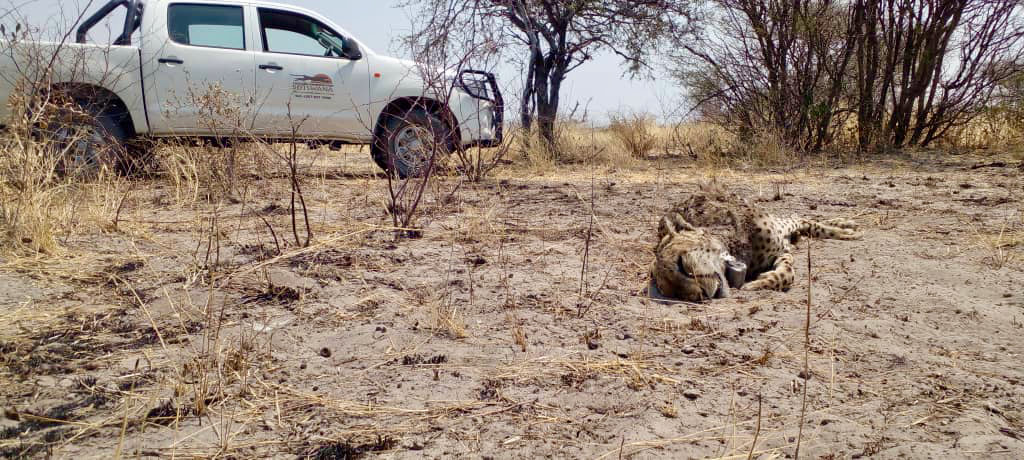Sadly, this cheetah was embroiled in a conflict case. The farmer lost 19 goats and sheep in a short period of time to predators, who broke into their nighttime livestock enclosure and killed livestock in large numbers. The farm owners were unsure whether the damage was caused largely by the cheetahs or the brown hyenas that denned nearby, but they set traps near the livestock boma in a bid to catch the culprit. Unfortunately, these traps weren’t the cage traps that we usually use to catch cheetahs for research, but gin traps – the southern African equivalent to a traditional foot-hold bear trap. These contraptions are fairly common for predator control in South Africa, but are more unusual in Botswana, where their use is prohibited by the Wildlife Act.
The farmers reluctantly admitted that they set the gin traps expecting to catch the hyena that they believed to be the culprit killing their livestock, but that they instead caught Ashton. Cheetahs’ bodies are built for speed, and their relatively fragile limbs are no match for a gin trap, which cut into Ashton’s ankle and injured it. Our team, together with the Department of Wildlife and National Parks and the Department of Veterinary Services veterinarian traveled to collect Ashton and bring him to our CCB camp. Here at our rehabilitation pen, Ashton was anaesthetized so that the vet could get a closer look at his injured ankle. What looked like a horrendous injury initially, turned out to be largely superficial – with deep lacerations but the all-important tendons and bones remained unharmed. The veterinarian cleaned the wound and administered long-lasting antibiotics to stave off infection.
Cheetahs living on farmlands survive by avoiding people. Where livestock and large carnivores mix, it is unsurprising that conflict occurs – so a cheetah that can live under the radar will be more likely to survive. With this in-built hyper aversion to people, Ashton was unsurprisingly anxious being held in our rehabilitation pen, no matter how much everyone minimized disturbance near the pen. Being obligate carnivores that usually don’t scavenge, he refused to eat any meat we put in the pen for him. Any approach by the veterinarian was met with hissing, spitting and growling. Following a second course of long-lasting Penicillin the veterinarian concluded that the sooner we could release him the better his chance of survival, a second opinion from another veterinarian who came to assess the situation agreed. Our team, along with government wildlife officers, mobilized and drove almost an entire day to Motopi waterhole in the Central Kalahari Game Reserve where he was released on 18th September.
Ideal cheetah habitat, with permanent water and plentiful game species, Motopi Pan was a veritable heaven for Ashton. We watched the GPS points from his collar closely in the following week, and although he was not moving as much as before his injury, we were confident that he was just resting his ankle. We were comforted by the fact that he was at least still moving. On the sixth day after release, he made a considerable move further south of the pan, what we hoped was a sign that his ankle was healing well and that he was out of the woods. But it wasn’t to last. On the 15th day after his release the points stopped moving briefly. We were hoping this indicated that he had perhaps made a kill and was settling with a full stomach, after all, a pause of a day is not completely unheard of. The GPS coordinates are programmed to record every two hours and then transmit the points collected to the satellite (which then we download onto our computers) twice a day. Due to the positioning of the satellites and the collar, there is occasionally a delay in the points uploading to the satellite and we can therefore have delays of up to 48 hours where no points will come through. As fate would have it, this is exactly what happened close to the time when Ashton stopped moving altogether. Once the points finally arrived, they showed us that Ashton had been completely still not just for one day, but for three, triggering the mortality alert. Our team, panicked and heartbroken, mobilized for the long trip into the Reserve. Despite our immediate action, the delay from the collar and the long drive meant that our team were too late. They arrived to find Ashton lying dead in the Kalahari sand, seemingly having succumbed to his injury.
Experiences like these are heartbreaking, but are important lessons based on which we can improve our work. We know now that although the current satellite technology that we use in our collars is adequate to monitor daily movements, land use preferences and movement patterns, we need to invest in trialing new technology tracking devices that somehow relay real-time data in this cell-signal-deficient landscape. We also need to come to terms with the reality that, conflict is something that ebbs and flows over time. We need to remain focused on protecting the species and addressing the threats that all the cheetahs here face. If we equip farmers with the knowledge that coexistence is possible and that with proactive preventative techniques, they will not need to use lethal measures like shooting or traps. Since Ashton’s capture and on CCB’s suggestion, the farmers that caught him have removed all gin traps from their farm, have taken measures to reinforce their livestock enclosure and are considering getting livestock guarding dogs to help protect their herds. Ashton may not have survived, but we’re hoping that because of this experience, we have possibly saved many more cheetahs that will move around this farm in the future.



 RSS Feed
RSS Feed
